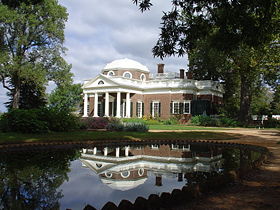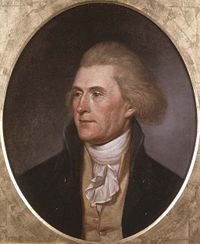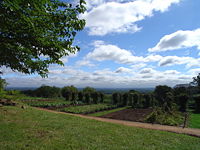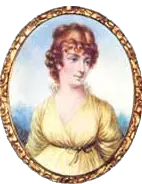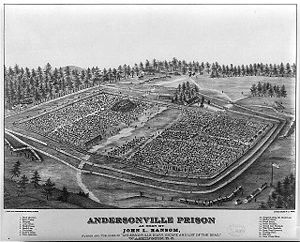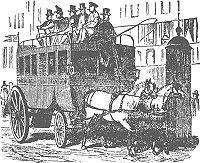Sally Hemings
| Sally Hemings | |
| Born | c. 1773 Shadwell, Albemarle County, Virginia |
|---|---|
| Died | 1835 Charlottesville, Virginia |
| Nationality | American |
| Occupation | Slave |
| Children | Harriet Hemings, Beverly Hemings, Eston Hemings, Madison Hemings |
| Relatives | James Hemings |
Sally Hemings (c. 1773 – 1835) was an American slave owned by Thomas Jefferson, believed to be the mother of several children belonging to him. She was also reportedly the illegitimate half-sister of Jefferson's deceased wife, Martha Wayles Skelton Jefferson.
After attending Jefferson and his daughters in Paris, she returned with him to Monticello in 1789, where, from 1795 to 1808, she bore five children who lived into adulthood. Rumors and newspaper reports about her relationship with Jefferson became an issue in American politics in the early 1800s. Hemings' son, Madison, published a memoir (1873) in which he claimed the he and his siblings were all fathered by Jefferson. Jefferson's legitimate children and grandchildren denied the claim, affirming that the Hemings children were the offspring of a nephew of Jefferson.
Reportedly, some of Sally Hemings' children, all of whom were light skinned and able to pass for being Caucasian, were allowed to leave Monticello without being pursued as runaway slaves. The rest were later freed. Sally herself remained in slavery until after Jefferson's death in 1826. She then lived with her children in Charlottesville until she deceased in 1835. While some of her children disappeared from the historical record, a number of her living descendants are still known.
Until the late twentieth century, historians tended to dismiss the allegation of Jefferson's relationship with Sally Hemings, but the controversy re-emerged in the late 1960s. DNA tests confirmed that a male in Jefferson's line, not one of the suggested nephews, was the father of at least one of Sally Hemings' children. Although circumstantial, evidence points to Jefferson.
Early life
Sally Hemings's mother, Betty Hemings, was the daughter of the English Captain Hemings and an enslaved African woman. Sally's family was owned by Jefferson's father-in-law, John Wayles, who died in 1773, leaving nearly all members of the Hemings family to his daughter Martha Jefferson. Several sources assert that Wayles was Sally Heming's father, making her and Martha Jefferson half-sisters. Martha Jefferson died in 1782, leaving the Hemings family to her husband, Thomas. The Hemings family was at the top of the slave "hierarchy" at Monticello indicating a special relationship to their owner, possibly of kinship.
With his wife deceased, Thomas Jefferson took up residence in Paris as the American envoy to France in 1784. In 1787, Jefferson sent for his second daughter, nine-year-old Maria (Polly). He asked that the slave Isabel, an older woman, be sent as a companion for Polly, but because Isabel was pregnant, the teen-aged Sally Hemings accompanied her instead. Stopping in London, Polly and Sally were met by John and Abigail Adams. Mrs. Adams expressed doubt concerning Sally's abilities, describing her as needing "more care than the child, and… wholly incapable of looking properly after her, without some superior to direct her."
Sally remained in France for 26 months, where her brother James, who had accompanied Jefferson to France in 1784, was learning to be a chef. Both Sally and James received wages while in France. There is no record of where Sally stayed. She may have stayed with Jefferson and her brother at the Hotel de Langoque or at the convent where Polly and her sister Martha were schooled. In either case, Jefferson and his retinue, including his daughters, spent weekends together at his villa.[1] The convent's bills do not seem to have included a boarding charge for Sally. Documentation does show that Jefferson purchased clothing for her, probably because she needed to accompany Martha to formal events.
Since slavery was illegal in France, under French law, both Sally and James could have petitioned to be released from Jefferson's ownership. According to her son Madison, Sally later indicated that she was aware that she could be free in France. He reported that she became pregnant by Jefferson and agreed to return to the United States as a slave only on the condition that Jefferson would agree to free her children, and that Jefferson agreed.
Children
Hemings did return to the U.S. with Jefferson in 1789. She seems to have lived most of the rest of her life at Monticello, and later in nearby Charlottesville, where she moved after Jefferson's death.
Some observers have noted inconsistencies in Jefferson's records regarding Hemings, including the fact that Jefferson did not note the father's name for Sally's children, although for some slaves' births he did note the father. According to Jefferson's records, she had six children:
- Harriet Hemings (I) (October 5, 1795-December 7, 1797)
- Beverly Hemings (a male, possibly born William Beverly Hemings) (April 1, 1798-after 1873)
- unnamed daughter (possibly named Thenia after Hemings's sister Thenia) (born in 1799 and died in infancy)
- Harriet Hemings (II) (May 22, 1801-after 1863)
- Madison Hemings (possibly born James Madison Hemings) (January 19, 1805-1877)
- Eston Hemings (possibly born Thomas Eston Hemings) (May 21, 1808-1856)[2]
According to the 1873 recollections of her son Madison, she also bore a child in 1790, conceived in France, who died soon after. According to controversial newspaper accounts and oral tradition this son was named Thomas.
Sally Hemings' duties included being a nursemaid-companion, lady's maid, chambermaid and seamstress. It is not known whether she was literate, and she left no known writings. She reportedly looked nearly white in appearance and had "straight hair down her back." Jefferson's grandson, Thomas Jefferson Randolph, described her as "light colored and decidedly good looking." As an adult, she may have lived in a room in Monticello's "South Dependencies," a wing of the mansion which was accessible to the main house through a covered passageway.
Sally Hemings never married. While she worked at Monticello, she was able to have her children nearby. According to her son Madison, they "were permitted to stay about the 'great house,' and only required to do such light work as going on errands." Madison reported that Jefferson was a kind man, but was "not in the habit" of showing fatherly affection to him and his siblings.
At age 14, the Hemings children began their training, the brothers in carpentry and Harriet as a spinner and weaver. Beverly, Madison, and Eston all learned to play the fiddle. In 1819 or 1820, a Jefferson granddaughter invited a friend to come to Monticello to "dance after Beverley's music" at the South Pavilion.
Beverly left the plantation in 1822, but was not pursued. Harriet followed in the same year. According to the plantation overseer Edmund Bacon, he gave her $50 and put her on a stagecoach, presumably to join her brother Beverly or another relative.
Later life
In Jefferson's references to Sally Hemings in his records, nothing distinguishes her as receiving special treatment. However, her extended family does appear to have been especially favored. Out of the hundreds of slaves he owned, Jefferson freed only two during his lifetime, Madison and Eston Hemings. He freed five additional slaves in his will, all from the Hemings family. He also seems to have allowed Harriet and Beverly to "escape" with his tacit consent. Jefferson also successfully petitioned the Virginia legislature to allow Hemings' sons Eston and Madison to remain in Virginia after they were free, an exception to a Virginia law requiring that freed slaves must leave within a year. Sally Hemings herself was never officially freed, although analysts point out that such an act would have certainly drawn scrutiny.
When appraisers arrived at Monticello after Jefferson's death to evaluate his estate, they described 56-year-old Sally Hemings as "an old woman worth $50."[3] Jefferson's legitimate daughter, Martha Randolph, then apparently gave Hemings her "time," a type of informal freedom which would allow her to continue to live in Virginia, where she lived out the rest of her life in Charlottesville with her sons. Researchers believe she was buried at a site in downtown Charlottesville, which now lies beneath a parking lot.
Controversy over her children
Prior to 1802, vague insinuations had been published in the Washington Federalist newspaper regarding Jefferson's alleged involvement with slaves. James T. Callender, a muckraking political journalist and former supporter of Jefferson, published a claim in the Richmond Recorder that Jefferson was the father of five children by Sally Hemings, including a son named Thomas. However, Callender had never visited Monticello and relied on second-hand information.
While the rumors promoted by Callender were unable to defeat Jefferson politically, they were a lasting source of concern in posterity, and for his friends and family, some of whom believed the rumors and some not. Jefferson's grandson, Thomas Jefferson Randolph, later admitted that Sally's children resembled Jefferson "so closely that it was plain that they had his blood in their veins."[4] John Adams wrote: "Callender and Sally will be remembered as long as Jefferson, as blots in his character. The story of the latter is a natural and almost unavoidable consequence of that foul Contagion in the human Character, Negro Slavery…"
Madison Hemings claimed in an 1873 memoir, edited by Samuel Wetmore, publisher of the Ohio newspaper, The Pike County Republican, that Thomas Jefferson was his father, as well as the father of all of Sally's children. He also revealed that his brothers and sister had passed into white society, successfully concealing their slave origins. Critics propose that the 1873 memoir had numerous factual errors and based more on Callender's articles that facts known personally to Madison Hemings. Some skeptics have also asserted that Madison's memoir exhibits a vocabulary unlikely to be used by a former slave, betraying the hand of the editor Samuel Wetmore—a Republican partisan and abolitionist.
Descendants of Thomas Woodson, a "free colored" man, published claims that he was Sally Hemings's son by Thomas Jefferson, conceived in France and born at Monticello in 1790. He was thus supposedly the "President Tom" of Callender's articles. However, DNA testing of five descendants of Woodson showed no relation to Jefferson.
Jefferson's comments
Thomas Jefferson himself never commented publicly on the issue, though some of his remarks have been interpreted as indirect denials or as a reason for his not liberating his own slaves. In his Notes on the State of Virginia, Jefferson confessed to a physical aversion towards dark-skinned Africans; however, according to the pseudo-scientific calculus of race to which he subscribed, the children of Sally Hemings, who was three-quarters white, would be both legally and by "blood," white.
In 1816, Jefferson wrote to George Logan that to deny something publicly increases the attention given to it. "I should have fancied myself half guilty, had I condescended to put pen to paper in refutation of their falsehoods, or drawn them respect by any notice from myself." Ten years later Jefferson wrote to Henry Lee saying, "There is not a truth existing which I fear or would wish unknown to the whole world."
Other claims
Monticello's overseer Edmund Bacon, whose recollections were transcribed by Reverend Hamilton Wilcox Pierson in 1862, in the book, The Private Life of Thomas Jefferson, said that Sally Hemings' daughter, presumably Harriet, was not Jefferson's. However, Pierson censored the name of the supposed father: "He (Jefferson) freed one girl some years before he died, and there was a great deal of talk about it. She was nearly as white as anybody, and very beautiful. People said he freed her because she was his own daughter. She was not his daughter, she was ______'s daughter. I know that. I have seen him come out of her mother's room many a morning when I went up to Monticello very early."[5] Skeptics of Bacon's testimony point out that Bacon's employment at Monticello commenced in 1806, five years after the birth of Harriet, and that he did not live at the "big house."
Two of Jefferson's grandchildren claimed the Hemings children had been fathered by one of Jefferson's nephews, either Samuel or Peter Carr, who had been raised at Monticello and were the sons of Jefferson's sister Martha.
Jefferson's granddaughter Ellen Randolph Coolidge wrote in a letter now at the University of Virginia archives of her grandfather:
His apartments had no private entrance not perfectly accessible and visible to all the household. No female domestic ever entered his chambers except at hours when he was known not to be there and none could have entered without being exposed to the public gaze.
Coolidge's recollection, however, is factually incorrect. In 1802-3, when Coolidge was six years old and living elsewhere, two hidden entrances to Jefferson's suite were built: An underground passageway used primarily by slaves, and two "porticles" which were built to screen two exterior entrances to Jefferson's study from public view. Anyone using these entrances would not be viewed from the parlor, the sitting room, dining room, and both first floor entrances.[6]
Jefferson's daughter, Martha Jefferson Randolph insisted that "Mr. Jefferson and Sally Hemings could not have met—were far distant from each other—for 15 months prior to the birth" of the child who most resembled Jefferson. However, no documentary evidence supports the assertion that either Jefferson or Hemings were absent for any length of time from Monticello in the relevant period.
Former Monticello slave Isaac Jefferson related in his memoirs that Jefferson's brother Randolph "was a mighty simple man: Used to come out among black people, play the fiddle and dance half the night." This is often cited as evidence supporting paternity by Randolph. However, Isaac left Monticello in 1797, and his account most likely refers to events of the early 1780s when Randolph was a young man.
Academic debate
Through most of the nineteenth and twentieth centuries, biographers of Jefferson dismissed suggestions that he had fathered children by a slave, if they mentioned the issue at all. In 1968, however Winthrop Jordan treated the Hemings-Jefferson link as plausible in his book White Over Black, noting that Jefferson was at Monticello every time Sally Hemings became pregnant. Fawn M. Brodie's 1974 biography of Jefferson assembled additional evidence about the Hemings family and the timing of Hemings' pregnancies, although some critics strongly objected to Brodie's psychoanalytic approach to Jefferson. Dumas Malone, Douglass Adair, Virginius Dabney, and other authors produced rebuttals to Brodie's argument, pointing to the Jefferson family's statements about the Carr brothers. While fictional portrayals of the relationship such as the novels Sally Hemings by Barbara Chase-Riboud and Arc d'X by Steve Erickson and the Merchant-Ivory film Jefferson in Paris reached large audiences and persuaded many, most mainstream historians continued to assert that there was insufficient evidence to conclude that Jefferson had a sexual relationship with any slave.
In 1997, law professor Annette Gordon-Reed published an examination of the arguments and available evidence, Thomas Jefferson and Sally Hemings: An American Controversy. She pointed out that most historians had used double standards to evaluate the evidence for and against the statements of Madison Hemings. For example, Hemings' statement about his father was labeled unreliable "oral history" while the oral tales passed down by the Jefferson family were treated as trustworthy, even though they contradicted each other and the documentary record. Historians also accepted statements about Sally's father being John Wayles based on little concrete evidence, but insisted on much more proof about Sally's children by Jefferson.
Gordon-Reed did not argue that documentary records proved Madison Hemings' claim, only that authors had unfairly dismissed it. She suggested that a conclusive answer might lie in developing more evidence through DNA analysis.
DNA testing
Relevant results were published in the November 5, 1998 issue of the British scientific journal Nature. The study compared the Y chromosomal haplotypes of four groups of men who were descendants of 1) Thomas Jefferson's grandfather 2) Thomas Woodson 3) Madison Hemings's brother Eston, and 4) John Carr, the grandfather of the Carr brothers.
The study's major findings were that the Y chromosome of the Jefferson family did match that of Eston Hemings' family, but did not match those of the Woodson and Carr families. The implications for the paternity question were not conclusive about whether Thomas Jefferson was the father, but strongly tended to disprove the contention of the Jefferson grandchildren that Sally Hemings's children had been fathered by one of the Carr brothers. The Woodson family's claim to have been descended from Jefferson was also disproven. On the other hand, Eston Hemings was undoubtedly the son of "a" Jefferson.
Other reports
Following the Nature article, the controversy continued to grow, and in 2000 and 2001 two major studies of the Jefferson-Hemings allegations were released. Both studies drew from a range of sources, including both scientific and historical, to arrive at their conclusions.
In January 2000, a group of specialists from the Thomas Jefferson Foundation, which owns and operates Monticello, published a study on the controversy initiated soon after the Nature paper. Their near-unanimous report stated that "although paternity cannot be established with absolute certainty, our evaluation of the best evidence available suggests the strong likelihood that Thomas Jefferson and Sally Hemings had a relationship over time that led to the birth of one, and perhaps all, of the known children of Sally Hemings."[7] This view is now given to visitors at Monticello by tour guides.
Later in 2000, the newly-formed Thomas Jefferson Heritage Society, whose stated purpose is to "further the honor and integrity of Thomas Jefferson," created a "Jefferson-Hemings Scholars Commission" composed of 13 noted conservative scholars to examine the paternity question. On April 12, 2001, the commission issued a report which concluded that "the Jefferson-Hemings allegation is by no means proven," noting that the likely alternative is that Randolph Jefferson, Thomas's younger brother, was the father of Eston and that 25 possible male Jeffersons lived in Virginia at the time, and eight of those lived close to or at Monticello. Dissenting from the majority opinion, Paul Rahe wrote that he considered "it somewhat more likely than not that Thomas Jefferson was the father of Eston Hemings." He added: "There is … one thing that we do know, and it is damning enough. Despite the distaste he expressed for the propensity of slaveholders and their relatives to abuse their power, Jefferson either engaged in such abuse himself or tolerated it on the part of one or more members of his extended family."[8]
The current consensus among American historians appears to have undergone a sea-change. Once, most scholars dismissed the idea that Jefferson fathered Hemings's children without examining the evidence closely. Today most historians agree that the story is more likely than not.
Legacy
Three of Hemings's children chose to pass as white. Two of them managed to effectively disappear from the historical record.
Eston Hemings moved to Ohio where, according to census records, he lived as a "mulatto," then moved to Wisconsin, changed his name to "Eston H. Jefferson" and lived as a white man. Madison Hemings, who also moved to Ohio, was the only child who did not choose to live as a white person.[9]
A good deal is known about Madison's and Eston's families. Both achieved some success in life, were respected by their contemporaries, and had children who repeated their success. They worked as carpenters, and Madison had a small farm. Eston became a professional musician and bandleader, "a master of the violin, and an accomplished 'caller' of dances." A neighbor described him as "quiet, unobtrusive, polite and decidedly intelligent; he was soon very well and favorably known to all classes of our citizens, for his personal appearance and gentlemanly manners attracted everybody's attention to him."[10]
Sons of both Madison and Eston served in the American Civil War. Madison's son, Thomas Eston Hemings, spent time at the Andersonville POW camp, and later died in a camp in Meridian, Mississippi. According to a Hemings descendant, his brother, James, attempted to cross Union lines and enlist in the Confederate army to rescue him.[11] Later, James was rumored to have moved to Colorado; like others in the family, he disappeared.
Eston's son John Wayles Jefferson wrote frequently for newspapers and published letters about his war experiences. He was proprietor of a hotel in Madison, Wisconsin. Ultimately he became a wealthy cotton broker in Tennessee.
Eston's son Beverly Jefferson was, according to his 1908 obituary, "a likable character at the Wisconsin capital, and a familiar of statesmen for half a century." He had operated a hotel with his brother, then built a successful horse-drawn "omnibus" business.[12]
Some of Madison Hemings' children and grandchildren who remained in Ohio suffered from the limited opportunities for blacks at that time, working as laborers, and servants or small farmers. William Hemings, Madison's last known male-line descendant, died in 1910, unmarried, in a veteran's hospital. Frederick Madison Roberts (1879-1952)—Sally Hemings' great-grandson and Madison's grandson—was the first person of known African American ancestry elected to public office on the West Coast. He served in the California State Assembly from 1919 to 1934.
See also
Notes
- ↑ Randall (1993), 475.
- ↑ Monticello, Thomas Jefferson and Sally Hemings: A Brief Account. Retrieved July 2, 2008.
- ↑ E.M. Halliday (2001), 120-122.
- ↑ Miller (1977), 154.
- ↑ Pierson (1967), 102.
- ↑ National Genealogical Society Quarterly 89 (3) September 2001: 206.
- ↑ Monticello, Monticello Foundation Report. Retrieved September 29, 2008.
- ↑ Robert F. Turner, Scholars Commission, The Wall Street Journal Opinion Journal. Retrieved August 30, 2008.
- ↑ Gordon-Reed, (1997), 148.
- ↑ Monticello, Appendix H: Sally Hemings and Her Children. Retrieved October 20, 2008.
- ↑ Brady Research, Mary Elizabeth Hemings Butler Lee Brady. Retrieved August 30, 2008.
- ↑ Wisconsin History, Beverly Jefferson Obituary. Retrieved August 30, 2008.
ReferencesISBN links support NWE through referral fees
- Brodie, Fawn M. Thomas Jefferson: An Intimate History. W. W. Norton & Company, 1998. ISBN 978-0393317527.
- Burton, Cynthia H. Jefferson Vindicated: Fallacies, Omissions, and Contradictions In the Hemings Genealogical Search. Self-published, 2005. ISBN 978-0976777502.
- Feldman, Jane, and Shannon Lanier. Jefferson's Children: The Story of One American Family. Random House, 2001. ISBN 978-0375821684.
- Gordon-Reed, Annette. Thomas Jefferson and Sally Hemings: An American Controversy. University of Virginia Press, 1997. ISBN 978-0813918334.
- Lewis, Jan, and Peter S. Onuf (eds.). Sally Hemings and Thomas Jefferson: History, Memory, and Civic Culture. University of Virginia Press, 1999. ISBN 978-0813919195.
- McMurry, Rebecca, and James. F. Jr. Anatomy of a Scandal, Thomas Jefferson and the Sally Story. White Mane Publishing Company, 2002. ISBN 978-1572493032.
- Malone, Dumas. Six-volume Biography of Thomas Jefferson. Little, Brown, 1948-1981. ISBN 978-1882886005.
- Pierson, Rev. Hamilton Wilcox. "Jefferson at Monticello: The Private Life of Thomas Jefferson." In James A. Bear (ed.), Jefferson at Monticello. Charlottesville: University of Virginia Press, 1967. ISBN 978-0813900223.
- Sloan, Sam. The Slave Children of Thomas Jefferson. Kiseido, 1998. ISBN 978-4906574001.
- Woodson, Byron W., Sr. A President in the Family: Thomas Jefferson, Sally Hemings, and Thomas Woodson. Praeger, 2001. ISBN 978-0275971748.
External links
All links retrieved August 31, 2019.
- Monticello account of Thomas Jefferson and Sally Hemings monticello.org
- Memoirs of Madison Hemings www.pbs.org
Credits
New World Encyclopedia writers and editors rewrote and completed the Wikipedia article in accordance with New World Encyclopedia standards. This article abides by terms of the Creative Commons CC-by-sa 3.0 License (CC-by-sa), which may be used and disseminated with proper attribution. Credit is due under the terms of this license that can reference both the New World Encyclopedia contributors and the selfless volunteer contributors of the Wikimedia Foundation. To cite this article click here for a list of acceptable citing formats.The history of earlier contributions by wikipedians is accessible to researchers here:
The history of this article since it was imported to New World Encyclopedia:
Note: Some restrictions may apply to use of individual images which are separately licensed.
